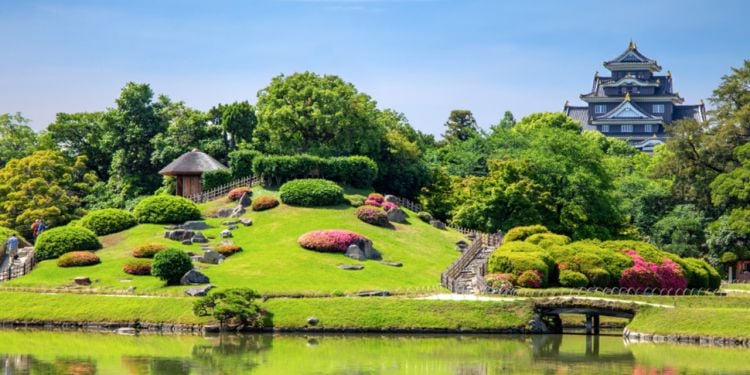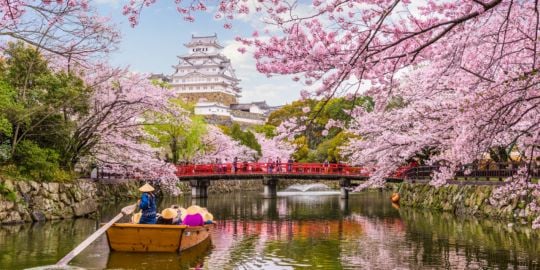Finding a job in Okayama

Ideally located between Fukuoka, Hiroshima, Tottori, Osaka and Kyoto, Okayama is a hot spot for businesses. It is a great opportunity for locals and foreigners who wish to work there. What are the key sectors of the city and the prefecture? How to look for a job? Here is a practical guide dedicated to living and working in Okayama.
Mapping Okayama
Geographical location
Okayama Prefecture is located in the Chugoku region, west of Honshu, the largest island in Japan. Okayama is bound by three large prefectures: Tottori to the north, Hyôgo to the east, with Kansai right next to it, and Hiroshima to the west. In the southwest, it is the island of Kyushu and the prefecture of Fukuoka. To the south of Okayama Prefecture lies the Seto Inland Sea. Big prefectures mean big cities. Okayama, a coastal city and capital of the prefecture of the same name, is surrounded by Fukuoka, Tottori, Hiroshima and Osaka. This is an ideal strategic position for companies and workers, both local and foreign. Okayama has its own airport, which connects it to Fukuoka, Kyoto and Osaka, in addition to international connections.
Population of Okayama
Okayama Prefecture has a population of just over 1.8 million, spread over 25 districts. After a steady increase in the middle of the '90s (about 1.9 million inhabitants), the population starts to decrease significantly from 2010. The decline is clear in the cities of Tsuyama, Takahashi, Niimi, Kasakoa or Bizen. In 15 years, they have lost 13,680, 14,043, 11,812, 14,390 and 12,535 inhabitants, respectively. All the cities of Okayama have lost inhabitants except Kurashiki and the capital Okayama. The capital has 724,691 inhabitants. Kurashiki, in the southwest, not far from Okayama, has 474,592 inhabitants. Kurashiki has gained 20,974 inhabitants in 15 years. Okayama gained 3 times more: 61,345.
In Okayama city, 40-49-year-olds are the most numerous (103,819 inhabitants), followed by 50-59-year-olds (87,210 inhabitants) and 70-79-year-olds (85,229 inhabitants). The 30-39-year-olds come in 5th (80,856 inhabitants) behind the 60-69-year-olds (79,702 inhabitants). Further proof of the demographic challenge Japan is facing (figures: Statistics Bureau of Japan)
Foreigners in Okayama
Okayama City wa home to 8048 foreigners in 2021. The city lost 905 foreign residents in 1 year. This decrease in foreign population is observed in all other regions of Japan. As a result of the health crisis, the country had a foreign population of about 2.8 million in June 2021. This is 3.7% less than in December 2019. At the same time, Japanese territories have also gained foreign residents. Okayama's neighbor Kurashiki gained 47 (figures: Japan Agency Immigration Services).
History of Okayama
Why is it called the "Land of the Sun"?
In the western prefecture of Japan, the sun shines about 277 days a year. The climate is mild. The average temperature is 9° in winter and 32° in the height of summer. The precipitations are moderate. This good balance explains the nickname of the prefecture and the richness of its agriculture. People rush to the farms to stock up on grapes and peaches.
The Land of Momotaro
Focus on Okayama city (literally "inside the mountain"). This is where the legend of Momotaro was born. In Japan, Momotaro is an institution. This folklore character is an integral part of Japanese people's daily life. Momo means "peach". Tarô is a name that was often given to the eldest son (it has since lost popularity with the younger generations). The legend of Momotaro comes from Okayama. The capital has capitalized on the history to offer festivals, onsen, attractions and "Momotaro" museums. A flourishing business that benefits tourism and makes the city vibrant.
Oyakama, Kôrakuen and the castle
Other very popular tourist attractions in the city are the Kôrakuen garden and the Okayama castle. Oyakama is "divided" into two main districts: the commercial and business district and the historical district. The first one, located in the city center, is home to shopping malls and other shopping centers. The second one invites you to contemplate and discover the culture. Kôrakuen is one of the most beautiful gardens in Japan. It is the pride of the locals and a passion for nature lovers. A little further away stands "Ujo", the "Black Crow" castle of Okayama. The building owes its name to the black planks covering its outer walls. It is opposed to its neighbor Himeji, "the castle of the white heron", referring to the whiteness of its outer walls.
The economic market of Okayama Prefecture
Okayama's economy is based on several sectors: textile, automobile industry, agriculture and trade. These sectors are dynamic and offer many employment opportunities for foreigners wishing to work in Okayama.
Okayama's trade partners
The prefecture's main trading partners are China, South Korea, Taiwan, the United States, Saudi Arabia, Australia, Kuwait and Indonesia. In 2021, the prefecture mainly exported to China for 22.2 billion yen. Other major exports were to South Korea (16.2 billion yen), Taiwan (10.1 billion yen), the United States (7.9 billion yen) and Thailand (7.2 billion yen). On the import side, the prefecture traded mainly with Saudi Arabia, amounting to 65.2 billion yen. It also imported from Australia (50.6 billion yen), Kuwait (31.8 billion yen), Indonesia (26.8 billion yen) and the United States (19.5 billion yen).
Import-export in Okayama
The prefecture is the 13th largest exporter and 8th largest importer in Japan (2021 figures). Among the main imports are petroleum oils, mineral oils, copper ores and concentrates, iron ores, etc. Exports were mainly copper cathodes, iron, steel, petroleum products, etc.
How to find a job in Okayama
The Japanese job market is still difficult to access. We are talking about "open-ended" jobs that allow you to obtain a work visa for Japan. This does not include odd jobs. Knowing the scope and structure of the Okayama market helps you to position yourself. There is no need to dissect the market thoroughly. The broad outlines will, in turn, give you an idea of your own abilities and limitations. For example, having a good knowledge of Japanese and English is essential. Speaking Arabic, Korean, Thai or other languages can open more doors depending on the field (international relations, import-export, finance, trade, etc.).
Today, many foreigners speak perfect Japanese and English. On what basis should an employer choose a candidate over another? Mastering a 3rd, 4th or 5th language can make a difference. Knowing the subtleties of the economic market of another country also weighs in the balance, depending on the job sector targeted.
Major companies in Okayama City
The city is a hub for many companies. Advanet is a leader in the production of computer hardware 100% made in Japan, from design to assembly. Biz-creation is an IT, information and management professional, just like Keii holdings, another giant in subsidiary management, asset management and sublease business. Olba Healthcare Holdings is specialized in the production of medical equipment.
On the industrial side, Metakote manufactures rubber and metal parts for the automotive market. In retail, the giant AEON has been making its mark since 2014, when it opened its shopping mall in Okayama. It is one of the largest in Japan. Two other big names have their stores in town: Takashimaya (next to Okayama Station) and Tenmaya (near Kôrakuen Garden). Tenmaya is an institution known especially for its wide choice of local fruits.
Major industries in Okayama
Agriculture
Close-up on the prefecture. The land of the sun is also the land of fruits and vegetables. In Okayama, white and golden peaches are grown. The Okayama Agricultural Research Institute has developed its own variety: "Okayama Yume Hakutou". Okayama also has its own variety of white and black grapes: "Muscat of Alexandria", "Pione", "Aurora Black", "Seto Giants", etc. The same goes for pears, with "Passe Crassane" or "Yari". As for vegetables, the prefecture grows eggplant, tomatoes, asparagus and yellow leeks, its specialty. The land of sunshine is also the land of soybean and rice. For soybean, Okayama has developed its "Black Soybean". For rice, it has developed 3 local productions: "Asahi rice", "Omachi rice" and "Himenomochi". Easyfarm, located in the Kibi Plateau, in the center of Okayama, is unique in its kind. Dynamic and innovative, it is also young (the average age is 30).
Contrary to popular belief, agriculture has always been at the forefront of technology and at the crossroads of many professions: industry, with the creation of agricultural machinery, research, engineering, health, bioenergy, construction, sales, marketing, etc., not forgetting, of course, the professions directly related to the land. Farmers and breeders are also innovating. Climate issues are creating new challenges and have accelerated the creation of new professions such as responsible brand communication or sustainable sourcing project manager.
The textile industry
In Okayama Prefecture, textiles are a leading industry. We have to go back to the Edo era to understand the origins of this success. At that time, the lands of Kojima and Kurashiki were drained to create cotton crops and equip the military and naval corps. Dyeing was soon added to the textile industry, strengthening Okayama's position. From the beginning of the 20th century, the prefecture became the supplier of schools. It produced up to 70% of the national needs. Okayama adapted to the synthetic revolution (the 1950s). Observing the new trends, the craftsmen were inspired by the famous American jeans before developing their own technique based on their ancestral know-how. The Japanese jean was born. The success is national and soon worldwide. Okamoto textile, Hishimoto, Sotoh group, Tango Weaver Union, Kurashiki Hanpu Canvas or JFA&C Selection are among the major textile companies in Okayama.
Want to work in textiles? As with agriculture, the textile and fashion industries are constantly reinventing themselves. Favoring natural fabrics over synthetic ones, fighting against fast fashion and greenwashing, etc. Textiles and fashion extend to much broader spheres of employment than their strict definition. Communication, merchandising, accounting, quality control, data analysis, social network management, without forgetting, of course, creative jobs such as pattern maker, textile engineer, fashion designer, leather goods maker, collection manager or production manager.
Other prominent fields in Okayama
Tourism and education are also great providers of employment in Okayama. Tourism also includes the hotel, restaurant and entertainment industries. Translation, interpreting, animation, communication, marketing, sales, advertising, web development, IT, administration, accounting, reception, etc. are other potential opportunities for foreign professionals in Japan. Okayama Prefecture is a well-placed tourist hub, between Kyushu, Kansai and Shikoku.
As for teaching, where you will find jobs in direct contact with students, administrative jobs, or communication jobs.
How to look for a job in Okayama?
The land of the sun is recruiting, but it is still necessary to access its offers. How to find work in the prefecture or the city of Okayama?
With what status did you come to Japan?
First of all, we need to take stock of the situation. Does your status allow you to work in Japan? And if so, are you limited? If you have a student visa or a Working Holiday Visa for Japan (WHV), you can only work 28 hours a week, and you are not allowed to work at night. With a tourist visa, you are not allowed to work in Japan. The WHV lasts only one year, after which you must leave the country. So no more permanent jobs. To work on a long-term basis, you will need a work visa.
Why Japan?
This may seem like a strange question, but it's worth asking. We sometimes have an idealized or erroneous vision of the country we intend to relocate to. Why did you leave your country? Why did you choose Japan? The goal is not to find a definitive answer but to guide your job search. Some foreigners simply want to have a new professional experience. Others have been dreaming of Japan for a long time. Others have specific skills in a field that is popular in Japan. Or you may not really know and may be making progress as you go along (but at least you know you are looking for a work visa).
Do you speak Japanese?
In Okayama, as elsewhere in Japan, job opportunities are abundant but are not always visible. The Japanese job market remains difficult to access, even for experienced graduates who speak the language. Speaking Japanese is not so "phenomenal" anymore. Years have passed, and thousands of foreigners speak Japanese today. Ask yourself why a company would hire you over someone else. So it's best that you speak several languages, starting with Japanese (a must for your professional integration and daily life), and English. Develop skills that are useful for the sector you are targeting.
Working in Japan: additional tips
Make the most of your experience, even if it is not professional: work in an association, a sports or cultural club, etc. Today, hard skills (technical skills) count as much as soft skills (interpersonal skills).
Develop your professional and informal network. Participate in job forums, meetings, webinars, etc., and join groups on social networks. Socialize also outside of work: sports clubs, cultural clubs, etc. Recreate your "own little world" in Japan.
Don't lose hope if your dream job is slow to come. Be patient, maximize your strengths and work on your weaknesses. Live your Japanese adventure by putting all the chances on your side.
Useful links:









